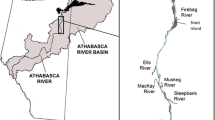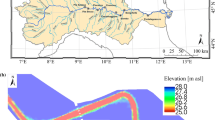Abstract
This paper identifies the coastal and river borne sediment sources and serves as a background for future work that serve to investigate possible coastal prevention strategies to limit the amount of sediment influx towards the entrance of Wairoa River, thus promoting its stability. The Wairoa River, a barrier enclosed estuary situated in Hawke’s Bay, New Zealand was modelled using a one-dimensional hydrodynamic model – DYNLET. The potential rate of transport for silt, sand and gravel were investigated for both a flood flow and a median flow using the method devised by Van Rijn (J Hydraul Eng, 133(6):649–667, 2007a and J Hydraul Eng, 133(6):668–689, 2007b). The gravel found deposited at the entrance was deemed to have originated from a coastal source whereas the silt and sand were found to be a result of fluvial processes.







Similar content being viewed by others
References
Amein M, and Kraus N (1991) DYNLET1: Dynamic Implicit Numerical Model of One-Dimensional Tidal Flow Through Inlets. US Army Engineer Waterways Experiment Station, Technical report CERC-91-10, 1–130
Annandale GW, Melville B, and Chiew YM (2002) Scour Case Studies. Mitteilungsblatt der Bundesanstalt für Wasserbau Nr. 85
Christie T, Thompson B, and Brathwaite B (2001) Mineral Commodity Report 22. Institute of Geological and Nuclear Sciences Limited, New Zealand Mining
Daykin N (2008) Bathymetry data, rainfall data, lower wairoa river flow data, dredging dates & wave buoy data 1988–2006. Hawkes Bay Regional Council, Napier
Gibb JG (1962) Wave refraction patterns in Hawkes Bay. N Z J Mar Freshw Res 5:435–444
Goodwin P (2004) Analytical solutions for estimating effective discharge. J Hydraul Eng 130(8):729–738
Gorman RW (2008) 1997 ~ 2007 Hawkes Bay wave climate data. National Institute of Water and Atmospheric Research (NIWA), New Zealand
Grant-Taylor TL (1966) Wairoa River. An Encyclopaedia of New Zealand, ed. AH McLintock, www.teara.govt.nz/en/1966 (accessed 2009–2014).
Komar PD (2007) The Coasts of Hawkes Bay: Processes & Erosion Problems. Hawkes Bay Regional Council, Report No. AM 07/02, HBRC Plan No. 3918.
Rosgen DL (1996) Applied river morphology. Wiland Hydrology Books, Pagiosia Springs
Van Rijn LC (2007a) Unified view of sediment transport by currents and waves. I: initiation of motion, Bed roughness, and Bed-load transport. J Hydraul Eng 133(6):649–667
Van Rijn LC (2007b) Unified view of sediment transport by currents and waves. II: Suspended Transport. J Hydraul Eng 133(6):668–689
Williams BJ (2006) Hydrobiological modelling: processes, numerical methods and applications. University of Newcastle, New South Wales
Yan B (2010) Use of one-dimensional modeling in estuary management: Potential sediment transport and entrance stability. Department of Mechanical and Aerospace Engineering, Monash University, Australia, Master thesis
Yan B, Jia YY, Hinwood JB (2013) Use of one-dimensional modelling in estuary management: entrance depth – model calibration. J Coast Conserv 17(1):191–196
Acknowledgements
This research would not have been possible without the generosity of Hawkes Bay Regional Council, in particular Neil Daykin for compiling and supplying river flow, rainfall and bathymetry data for Wairoa River. Many thanks to Dr. Richard Gorman from NIWA and Keith Rodel from the Port of Napier for additional data.
Author information
Authors and Affiliations
Corresponding author
Rights and permissions
About this article
Cite this article
Jia, Y., Yan, B. & Hinwood, J.B. Use of one-dimensional modelling in estuary management: sediment source. J Coast Conserv 18, 631–641 (2014). https://doi.org/10.1007/s11852-014-0335-y
Received:
Revised:
Accepted:
Published:
Issue Date:
DOI: https://doi.org/10.1007/s11852-014-0335-y




